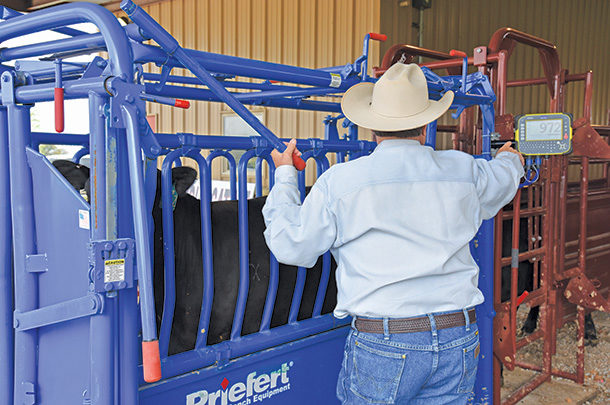Identifying the best weigh scale set-up for your individual operation can be a weighty decision. When thinking about the different options available from manufacturers, there are three important questions producers can ask themselves to help identify the best layout for their ranch. But before reading into those, let’s first look at how weigh scale systems can add value to livestock operations and how operations can, in turn, be at financial risk by not monitoring individual weights. Whether you are managing a smaller cattle operation or a large feedlot, by closely monitoring individual bodyweights, you can help increase profit.
Improved reproductive performance
By knowing individual weights, producers can maximize reproductive performance and profit through timing, calving ease, bull selection and improved overall calf health. “Having this information about each animal helps set production parameters, so producers can know which are their best sets of cows that are producing the best sets of calves,” says Arnold Nagely, DVM, co-founder of Valley Vet Supply. “Our main goal is to make breeding decisions that improve the overall genetics of our calf crop. Make sure you are continually keeping back the highest-producing cows that will improve your herd’s genetics for heavier calves down the road.”
Effective management of weight gain

Weight scale indicators help you maintain data in the processing stages. Photos courtesy of Datamars.
Cattlemen can easily monitor the rate of weight gain for individual cattle. This allows for tailored feeding programs, more closely tracking input costs and optimum sale-day weights. It also helps identify those animals with the greatest feed efficiency, as well as monitor your top performers and poor performers for more effective culling decisions. “Another thought is how different rates of gain will require specific rations, or perhaps an implant, to continue boosting performance,” Nagely says.
Reduced treatment cost and wasted medications
Medications and parasite control products are dosed to an animal’s individual weight. By eliminating the practice of eyeballing weights, producers can maximize the health of livestock with more accurate dosing. “By keeping a more watchful eye, producers can help ensure their ranch is as profitable as possible for the generations to come,” says Nagely. “Having individual weights also means accurate antibiotic dosage and improved treatment response that can result in fewer re-pulls and re-treats. Something that can seem so simple as getting the right weight can make a profound impact on a producer’s bottom line.”
Cattle operations can experience significant loss by not monitoring weight gain, according to Jason Jones at Datamars, who shared two real-life examples.
Example No. 1: Feeding and forecasting
A ranch aimed to market their 700-pound steers at 800 pounds, which should have taken 40 days at a rate of 2.5 pounds average daily gain (ADG). By not closely monitoring weight gain, they achieved only 2.3 ADG, putting the 62 head of steers at 8 pounds less than the desired market weight. This resulted in a loss of $545.60 per semitruck load come market time.
Example No. 2: First-conception breeding
For cow-calf operations, first conception is a deal-breaker, says Jones. Ideally, a heifer being 60% to 65% of her mature cow weight is optimal for first breeding; thus, tracking weight gain is critical for targeting breeding dates. Every missed cycle puts a heifer (and her calf) back by 21 days. Consider that, on average, calves gain 2 pounds per day while on the cow; by missing the first cycle, this could result in a loss of about $60 per calf.
When weighing the options, where does one begin? Here are three questions Jones recommends asking yourself when selecting livestock scales to help ensure the system is right for your specific needs.
Do you need the scale to be portable or permanent? If you have livestock located across different sections, going with a portable platform scale will allow you to easily transport the system to the cattle. When you are weighing livestock by portable installation, simply set up the scale system before the entrance into the squeeze chute to capture weights.

To build a complete system, producers will need a weigh scale indicator, a squeeze chute, load bars or load cells, EID reader and EID eartags. Photo courtesy of Datamars.
Looking to weigh cattle in the same location they will be processed? If so, your most ideal option will be to have a permanent installation, in which load bars are placed under your squeeze chute and bolted to concrete. “Remember,” encourages Jones, “the more level the load bar is, the more accurate it will be.” Determining whether you will have a portable or permanent installation will drive which load bars you need to complete your system.
Why do you need a weigh scale indicator? A weigh scale indicator is the physical readout of the animal’s weight. There are several models of weigh scale indicators available. Producers can select from basic to more advanced models which can interface with other technologies, such as electronic identification (EID) eartag readers, allowing producers to automatically sync data into their digital record-keeping programs. With a more advanced weigh scale indicator, producers can rest easy knowing information is captured correctly and automatically into their computer system. “You can connect the scale indicators to your computer and click ‘download.’ By combining data collection with weights and EID technology, you can save a lot of time,” Jones says.
How will you incorporate data into management practices? This is an important factor when deciding which scale indicator model is the best option for you. From the more basic models to the most advanced, producers can use this data for their operation’s advantage. Basic models are used to simply track animal weights for health monitoring and marketing purposes. For more advanced management practices, some producers may be using the scale indicator to capture data such as breed, sex, pregnancy check or sire/dam. Some indicators also allow producers to group animals together based on various characteristics.
In closing, Nagely says, “There are several models of weigh scale indicators out there, from basic to more advanced models. The more basic models are used to simply track animal weights for health monitoring and marketing purposes, while some indicators will house the vaccines and antibiotics administered, even the serial numbers. Some will even have a dosage calculator. To build a complete system, producers will need a weigh scale indicator, a squeeze chute, load bars or load cells, EID reader and EID eartags. If producers run into any questions, they can always call us. We’re always happy to help and point them in the right direction.”










